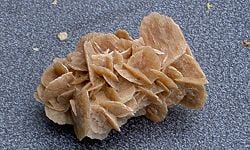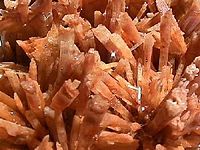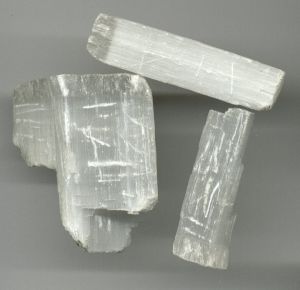Difference between revisions of "Gypsum" - New World Encyclopedia
(added credit and category tags, deleted foreign language links) |
(→Notes) |
||
| Line 34: | Line 34: | ||
}} | }} | ||
| − | '''Gypsum''' is a very soft [[mineral]] composed of [[calcium sulfate]] dihydrate, with the [[chemical formula]] CaSO<sub>4</sub>·2H<sub>2</sub>O. | + | '''Gypsum''' is a very soft [[mineral]] composed of [[calcium sulfate]] dihydrate, with the [[chemical formula]] CaSO<sub>4</sub>·2H<sub>2</sub>O. It is widespread in nature and is extremely useful for many practical applications. |
==Crystal varieties== | ==Crystal varieties== | ||
| − | [[Image:Gypsum Australia.jpg|thumb|left|200px|Gypsum from New South Wales, Australia]] | + | [[Image:Gypsum Australia.jpg|thumb|left|200px|Gypsum from New South Wales, Australia.]] |
| + | |||
Gypsum occurs in nature as flattened and often [[crystal twinning|twinned]] [[crystal]]s and transparent cleavable masses called [[selenite]]. It may also occur silky and fibrous, in which case it is commonly called ''satin spar''. Finally it may also be granular or quite compact. In hand-sized samples, it can be anywhere from transparent to opaque. A very fine-grained white or lightly-tinted variety of gypsum is called [[alabaster]], which is prized for ornamental work of various sorts. In arid areas, gypsum can occur in a flower-like form typically opaque with embedded sand grains called [[desert rose (crystal)|desert rose]]. | Gypsum occurs in nature as flattened and often [[crystal twinning|twinned]] [[crystal]]s and transparent cleavable masses called [[selenite]]. It may also occur silky and fibrous, in which case it is commonly called ''satin spar''. Finally it may also be granular or quite compact. In hand-sized samples, it can be anywhere from transparent to opaque. A very fine-grained white or lightly-tinted variety of gypsum is called [[alabaster]], which is prized for ornamental work of various sorts. In arid areas, gypsum can occur in a flower-like form typically opaque with embedded sand grains called [[desert rose (crystal)|desert rose]]. | ||
==Occurrence== | ==Occurrence== | ||
| + | |||
Gypsum is a very common mineral, with thick and extensive [[evaporite]] beds in association with [[sedimentary rock]]s. The largest deposits known occur in [[stratum|strata]] from the [[Permian]] age. Gypsum is deposited in lake and sea water, as well as in [[hot spring]]s, from [[volcano|volcanic]] vapors, and sulfate solutions in [[Vein (geology)|veins]]. [[Hydrothermal]] [[anhydrite]] in veins is commonly hydrated to gypsum by groundwater in near surface exposures. It is often associated with the minerals [[halite]] and [[sulfur]]. | Gypsum is a very common mineral, with thick and extensive [[evaporite]] beds in association with [[sedimentary rock]]s. The largest deposits known occur in [[stratum|strata]] from the [[Permian]] age. Gypsum is deposited in lake and sea water, as well as in [[hot spring]]s, from [[volcano|volcanic]] vapors, and sulfate solutions in [[Vein (geology)|veins]]. [[Hydrothermal]] [[anhydrite]] in veins is commonly hydrated to gypsum by groundwater in near surface exposures. It is often associated with the minerals [[halite]] and [[sulfur]]. | ||
| − | [[Image:GipsitaEZ.jpg|thumb|right|Fibrous | + | [[Image:GipsitaEZ.jpg|thumb|right|Fibrous gypsum from Brazil.]] |
| + | |||
The word gypsum is derived from the [[aorist]] form of the [[Greek language|Greek]] verb ''μαγειρεύω'', "to cook", referring to the burnt or calcined mineral. Because the gypsum from the [[quarry|quarries]] of the [[Montmartre]] district of [[Paris]] has long furnished burnt gypsum used for various purposes, this material has been called plaster of Paris. | The word gypsum is derived from the [[aorist]] form of the [[Greek language|Greek]] verb ''μαγειρεύω'', "to cook", referring to the burnt or calcined mineral. Because the gypsum from the [[quarry|quarries]] of the [[Montmartre]] district of [[Paris]] has long furnished burnt gypsum used for various purposes, this material has been called plaster of Paris. | ||
| Line 50: | Line 53: | ||
Commercial quantities of gypsum are found in [[Germany]], [[Italy]], [[England]], [[Ireland]], in [[British Columbia]], [[Manitoba]], [[Ontario]], [[Nova Scotia]] and [[Newfoundland]] in [[Canada]],<ref name='Mining Canada'>{{cite web|url=http://mmsd1.mms.nrcan.gc.ca/mmsd/producers/commodityCompany_e.asp?nId=51&mineType=nonMetal |title=Mines, Mills and Concentrators in Canada |accessdate=2007-01-27 |date=2005-10-24 |publisher=Natural Resources Canada }}</ref> and in [[New York]], [[Michigan]], [[Iowa]], [[Kansas]], [[Oklahoma]], [[Arizona]], [[New Mexico]], [[Colorado]], [[Utah]] and [[Nevada]] in the [[United States]]. There is also a large mine located at Plaster City, California in Imperial County. There are commercial quantities in East Kutai, Kalimantan. | Commercial quantities of gypsum are found in [[Germany]], [[Italy]], [[England]], [[Ireland]], in [[British Columbia]], [[Manitoba]], [[Ontario]], [[Nova Scotia]] and [[Newfoundland]] in [[Canada]],<ref name='Mining Canada'>{{cite web|url=http://mmsd1.mms.nrcan.gc.ca/mmsd/producers/commodityCompany_e.asp?nId=51&mineType=nonMetal |title=Mines, Mills and Concentrators in Canada |accessdate=2007-01-27 |date=2005-10-24 |publisher=Natural Resources Canada }}</ref> and in [[New York]], [[Michigan]], [[Iowa]], [[Kansas]], [[Oklahoma]], [[Arizona]], [[New Mexico]], [[Colorado]], [[Utah]] and [[Nevada]] in the [[United States]]. There is also a large mine located at Plaster City, California in Imperial County. There are commercial quantities in East Kutai, Kalimantan. | ||
| + | == See also == | ||
| + | * [[Calcium]] | ||
| + | * [[Crystal]] | ||
| + | * [[Mineral]] | ||
| + | |||
| + | == Notes == | ||
| + | <references/> | ||
==References== | ==References== | ||
| − | + | ||
| − | * Klein, Cornelis and | + | * Farndon, John. 2006. ''The Practical Encyclopedia of Rocks & Minerals: How to Find, Identify, Collect and Maintain the World's best Specimens, with over 1000 Photographs and Artworks''. London: Lorenz Books. ISBN 0754815412. |
| − | * | + | |
| − | * | + | * Klein, Cornelis, and Barbara Dutrow. 2007. ''Manual of Mineral Science''. 23rd ed. New York: John Wiley. ISBN 978-0471721574. |
| + | |||
| + | * Pellant, Chris. 2002. ''Rocks and Minerals''. Smithsonian Handbooks. New York: Dorling Kindersley. ISBN 0789491060. | ||
| + | |||
| + | * Shaffer, Paul R., Herbert S. Zim, and Raymond Perlman. 2001. ''Rocks, Gems and Minerals''. Rev. ed. New York: St. Martin's Press. ISBN 1582381321. | ||
==External links== | ==External links== | ||
| − | + | ||
| + | * [http://minerals.usgs.gov/minerals/pubs/commodity/gypsum/ Gypsum: Statistics and Information.] ''U.S. Geological Survey''. Retrieved April 13, 2007. | ||
| + | |||
| + | * [http://webmineral.com/data/Gypsum.shtml Gypsum Mineral Data.] ''WebMineral.com''. Retrieved April 13, 2007. | ||
| + | |||
| + | * [http://www.mindat.org/min-1784.html Gypsum.] ''Mindat.org''. Retrieved April 13, 2007. | ||
[[Category:Physical sciences]] | [[Category:Physical sciences]] | ||
Revision as of 16:50, 13 April 2007
- For other uses, see Gypsum (disambiguation).
| Gypsum | |
|---|---|
 Desert rose, 10 cm long |
|
| General | |
| Category | Mineral |
| Chemical formula | CaSO4·2H2O |
| Identification | |
| Color | White to grey, pinkish-red |
| Crystal habit | Massive, flat. Elongated and generally prismatic crystals |
| Crystal system | Monoclinic 2/m |
| Twinning | common {110} |
| Cleavage | 2 good (66° and 114°) |
| Fracture | Conchoidal, sometimes fibrous |
| Mohs Scale hardness | 1.5-2 |
| Luster | Vitreous to silky or pearly |
| Refractive index | α=1.520, β=1.523, γ=1.530 |
| Optical Properties | 2V = 58° + |
| Pleochroism | None |
| Streak | White |
| Specific gravity | 2.31 - 2.33 |
| {{{density}}} | |
| Fusibility | 3 |
| Solubility | hot, dilute HCl |
| Diaphaneity | transparent to translucent |
| Major varieties | |
| Satin Spar | Pearly, fibrous masses |
| Selenite | Transparent and bladed crystals |
| Alabaster | Fine-grained, slightly colored |
Gypsum is a very soft mineral composed of calcium sulfate dihydrate, with the chemical formula CaSO4·2H2O. It is widespread in nature and is extremely useful for many practical applications.
Crystal varieties
Gypsum occurs in nature as flattened and often twinned crystals and transparent cleavable masses called selenite. It may also occur silky and fibrous, in which case it is commonly called satin spar. Finally it may also be granular or quite compact. In hand-sized samples, it can be anywhere from transparent to opaque. A very fine-grained white or lightly-tinted variety of gypsum is called alabaster, which is prized for ornamental work of various sorts. In arid areas, gypsum can occur in a flower-like form typically opaque with embedded sand grains called desert rose.
Occurrence
Gypsum is a very common mineral, with thick and extensive evaporite beds in association with sedimentary rocks. The largest deposits known occur in strata from the Permian age. Gypsum is deposited in lake and sea water, as well as in hot springs, from volcanic vapors, and sulfate solutions in veins. Hydrothermal anhydrite in veins is commonly hydrated to gypsum by groundwater in near surface exposures. It is often associated with the minerals halite and sulfur.
The word gypsum is derived from the aorist form of the Greek verb μαγειρεύω, "to cook", referring to the burnt or calcined mineral. Because the gypsum from the quarries of the Montmartre district of Paris has long furnished burnt gypsum used for various purposes, this material has been called plaster of Paris.
Because gypsum dissolves over time in water, gypsum is rarely found in the form of sand. However, the unique conditions of the White Sands National Monument in the US state of New Mexico have created a 710 km² (275 sq mile) expanse of white gypsum sand, enough to supply the construction industry with drywall for 1,000 years.[1] Commercial exploitation of the area, strongly opposed by area residents, was permanently prevented in 1933 when president Herbert Hoover declared the gypsum dunes a protected national monument.
Commercial quantities of gypsum are found in Germany, Italy, England, Ireland, in British Columbia, Manitoba, Ontario, Nova Scotia and Newfoundland in Canada,[2] and in New York, Michigan, Iowa, Kansas, Oklahoma, Arizona, New Mexico, Colorado, Utah and Nevada in the United States. There is also a large mine located at Plaster City, California in Imperial County. There are commercial quantities in East Kutai, Kalimantan.
See also
Notes
- ↑ Abarr, James, "Sea of Sand", The Albuquerque Journal, 1999-02-07. Retrieved 2007-01-27.
- ↑ Mines, Mills and Concentrators in Canada. Natural Resources Canada (2005-10-24). Retrieved 2007-01-27.
ReferencesISBN links support NWE through referral fees
- Farndon, John. 2006. The Practical Encyclopedia of Rocks & Minerals: How to Find, Identify, Collect and Maintain the World's best Specimens, with over 1000 Photographs and Artworks. London: Lorenz Books. ISBN 0754815412.
- Klein, Cornelis, and Barbara Dutrow. 2007. Manual of Mineral Science. 23rd ed. New York: John Wiley. ISBN 978-0471721574.
- Pellant, Chris. 2002. Rocks and Minerals. Smithsonian Handbooks. New York: Dorling Kindersley. ISBN 0789491060.
- Shaffer, Paul R., Herbert S. Zim, and Raymond Perlman. 2001. Rocks, Gems and Minerals. Rev. ed. New York: St. Martin's Press. ISBN 1582381321.
External links
- Gypsum: Statistics and Information. U.S. Geological Survey. Retrieved April 13, 2007.
- Gypsum Mineral Data. WebMineral.com. Retrieved April 13, 2007.
- Gypsum. Mindat.org. Retrieved April 13, 2007.
Credits
New World Encyclopedia writers and editors rewrote and completed the Wikipedia article in accordance with New World Encyclopedia standards. This article abides by terms of the Creative Commons CC-by-sa 3.0 License (CC-by-sa), which may be used and disseminated with proper attribution. Credit is due under the terms of this license that can reference both the New World Encyclopedia contributors and the selfless volunteer contributors of the Wikimedia Foundation. To cite this article click here for a list of acceptable citing formats.The history of earlier contributions by wikipedians is accessible to researchers here:
The history of this article since it was imported to New World Encyclopedia:
Note: Some restrictions may apply to use of individual images which are separately licensed.

